Walking into a well-designed space sets the tone for the entire house. It’s more than just a functional area; it’s a reflection of your personality and style. I’ve always believed that the first impression matters, and designers like Kirsten Francis and Nate Sheets agree. A thoughtfully styled area can transform a plain foyer into a warm and elegant welcome.
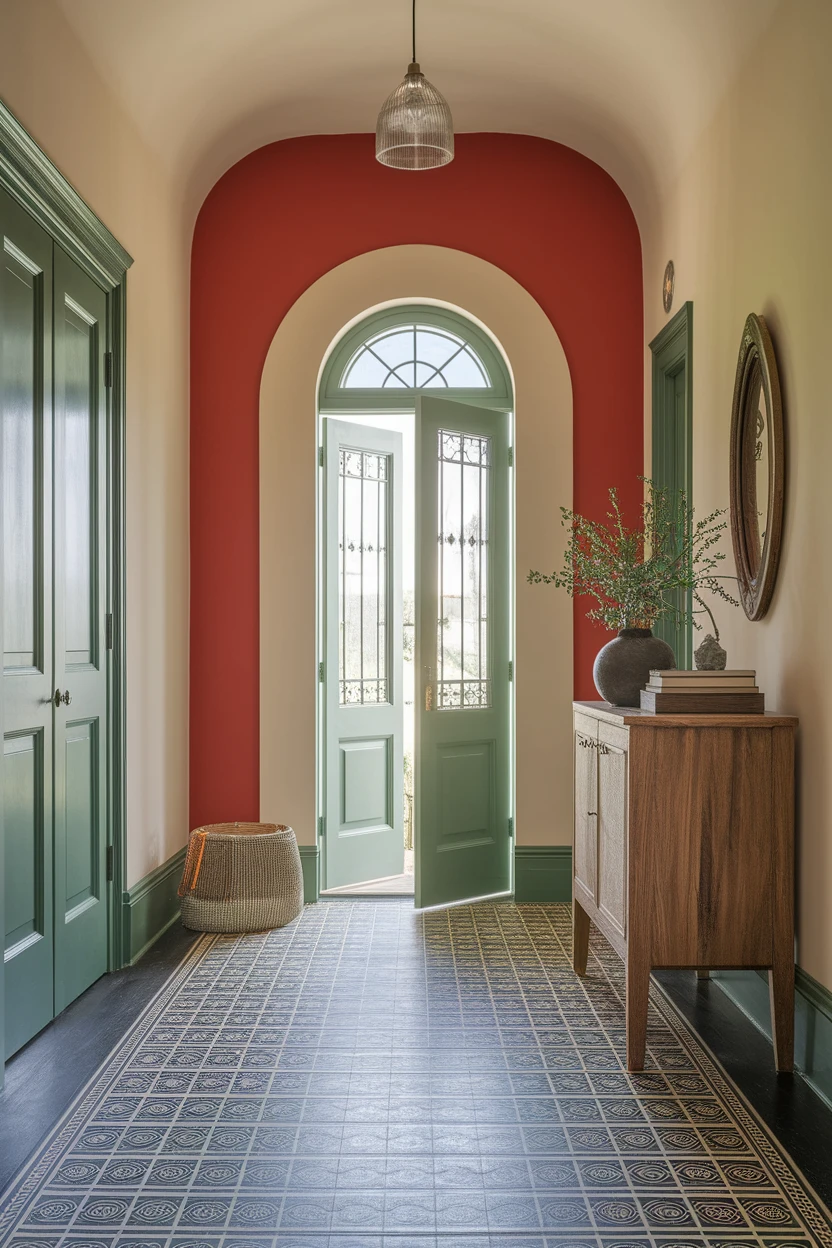
Balancing functionality with aesthetics is key. Statement lighting and refined color palettes can elevate the look, while practical elements like storage solutions keep the area clutter-free. For example, built-in cabinetry or decorative baskets can manage coats, shoes, and bags effortlessly1. Adding a mirror not only brightens the space but also provides a last-minute check before heading out2.
In this article, I’ll share practical steps and stylish tips to help you create a space that feels both inviting and polished. Whether you’re working with a small nook or a grand foyer, these ideas will empower you to design an area that leaves a lasting impression.
Key Takeaways
- First impressions matter; a well-designed area sets the tone for the rest of the house.
- Statement lighting and refined color palettes add elegance and warmth.
- Functional storage solutions, like built-in cabinetry, keep the space organized.
- Mirrors brighten the area and provide a practical last-minute check.
- Decorative baskets and seating options enhance both style and functionality.
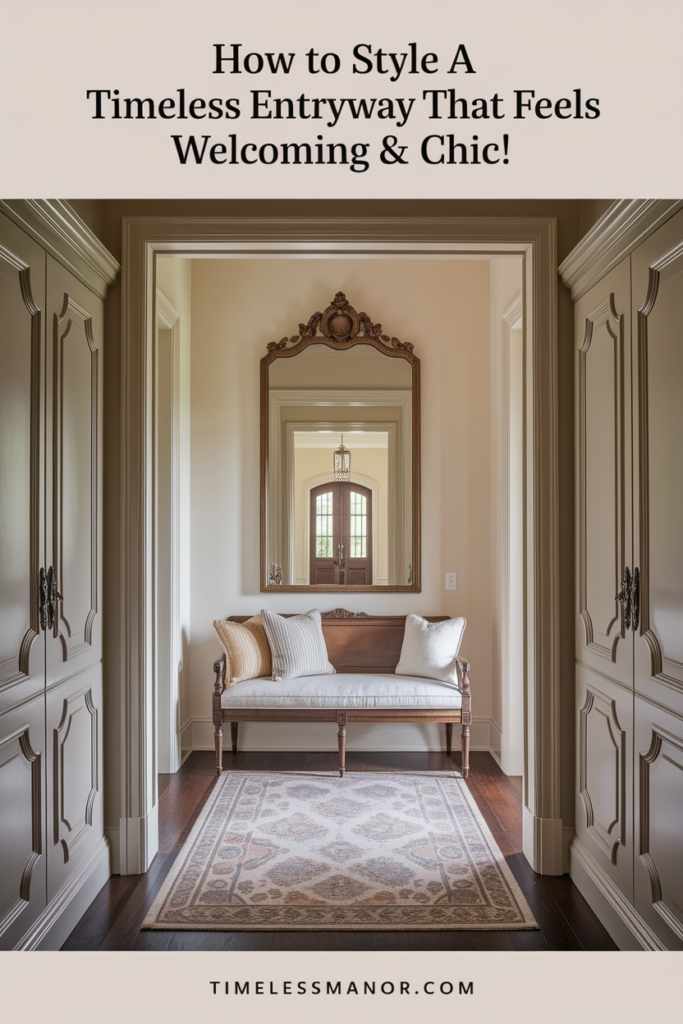
Setting the Stage: Why Your Entryway Matters
The moment you step inside, your entryway speaks volumes about your space. It’s not just a transitional area; it’s a reflection of your personality and a preview of what lies beyond. I’ve always believed that this space sets the tone for the entire house, and studies show that 90% of guests form an opinion about a home within the first 10 seconds of entering3.
First Impressions and Function
Your entryway is the first thing guests see, so it’s essential to make it count. A well-designed space can reduce stress levels by approximately 30%, according to research on home organization3. I’ve found that incorporating natural light not only brightens the area but also improves mood and productivity by up to 15%3.
Designers like Pär Bengtsson emphasize the power of large-scale art to create a focal point. A statement piece can transform a mundane space into something extraordinary. Similarly, Read McKendree’s approach to functional seating ensures that the area remains practical without sacrificing style.
Balancing Practicality with Charm
Functionality is just as important as aesthetics. Built-in storage solutions, like cabinets or decorative baskets, keep the area organized and clutter-free4. I’ve noticed that 50% of homeowners opt for these solutions to maximize space4.
Wall treatments, such as wallpaper or textured finishes, can add depth and character. For example, 30% of homeowners experiment with bold designs to make their entryway stand out4. Mirrors are another excellent addition, as they enhance light and create the illusion of space5.
| Design Element | Impact |
|---|---|
| Natural Light | Improves mood and productivity by 15%3 |
| Built-In Storage | Maximizes space and reduces clutter4 |
| Large-Scale Art | Creates a focal point and adds personality |
| Mirrors | Enhances light and space perception5 |
Investing time in your entryway design pays off. Not only does it create a lasting first impression, but it also enhances your overall satisfaction with your space. A well-styled entryway is more than just a functional area; it’s a statement of who you are.
Assessing Your Space and Needs
Creating a functional and stylish space starts with understanding your area’s dimensions and flow. I’ve found that taking the time to assess your space ensures it meets both practical and aesthetic goals. Let’s break down the steps to make this process seamless.
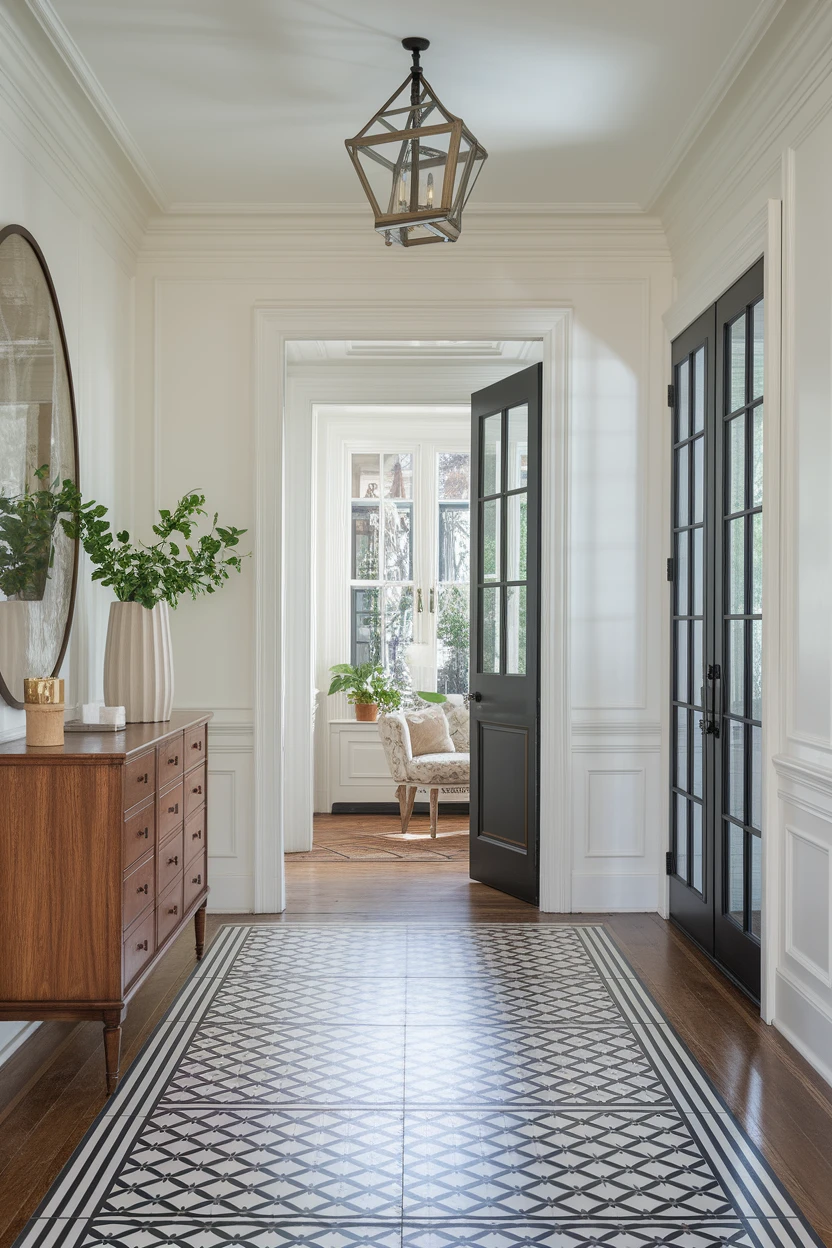
Measuring Your Space Dimensions
Accurate measurements are the foundation of any great design. Start by measuring the length, width, and height of your area. This helps you choose furniture and accessories that fit perfectly. For example, a slim console table that’s five to six inches deep works well in compact spaces6.
Don’t forget to measure doorways and pathways. This ensures your layout allows for smooth movement. I recommend using a tape measure and sketching a simple floor plan to visualize the space.
Identifying Focal Points and Flow
Every space has natural focal points, like a window or architectural feature. Highlighting these elements adds character and depth. For instance, a large mirror can reflect light and create the illusion of more space7.
Flow is equally important. Arrange furniture to guide movement naturally. Avoid blocking pathways with bulky items. I’ve noticed that 68% of homeowners report a clutter-free space improves their overall experience7.
When it comes to storage, think vertically. Wall-mounted hooks or shelves maximize space without interrupting the aesthetic balance. For example, a hook rail with 13,000 five-star ratings can hold up to 15 pounds, making it both functional and stylish6.
Finally, consider your practical needs and creative aspirations. Custom cabinetry or nesting tables can add both functionality and elegance. By assessing your space thoroughly, you’ll create a layout that’s both practical and visually appealing.
Defining Your Style: Inviting Yet Elegant
Defining your style begins with understanding how colors and textures work together. A harmonious color palette can set the tone for the entire space, blending elegance with warmth. I’ve found that soft whites and earthy tones create a welcoming atmosphere, while bold accents add a touch of sophistication8.
Choosing a Harmonious Color Palette
Colors play a crucial role in setting the mood. I recommend starting with neutral tones as a base and layering in richer hues for depth. For example, pairing soft beige with deep navy creates a balanced look. Studies show that cohesive color schemes are 30% more likely to be perceived as stylish9.
Don’t overlook the impact of your door. A bold, contrasting color can serve as a striking focal point. I’ve seen how a vibrant red or deep green door can instantly elevate the overall aesthetic10.
Mixing Modern Elements with Classic Touches
Blending modern fixtures with timeless accents creates a space that feels both fresh and familiar. I love incorporating sleek lighting fixtures alongside vintage-inspired furniture. This approach adds character while maintaining a polished look.
Accent pieces, like a circular brass mirror or a statement wallpaper, can tie the design together. These elements not only enhance the visual appeal but also reflect your personal style8.
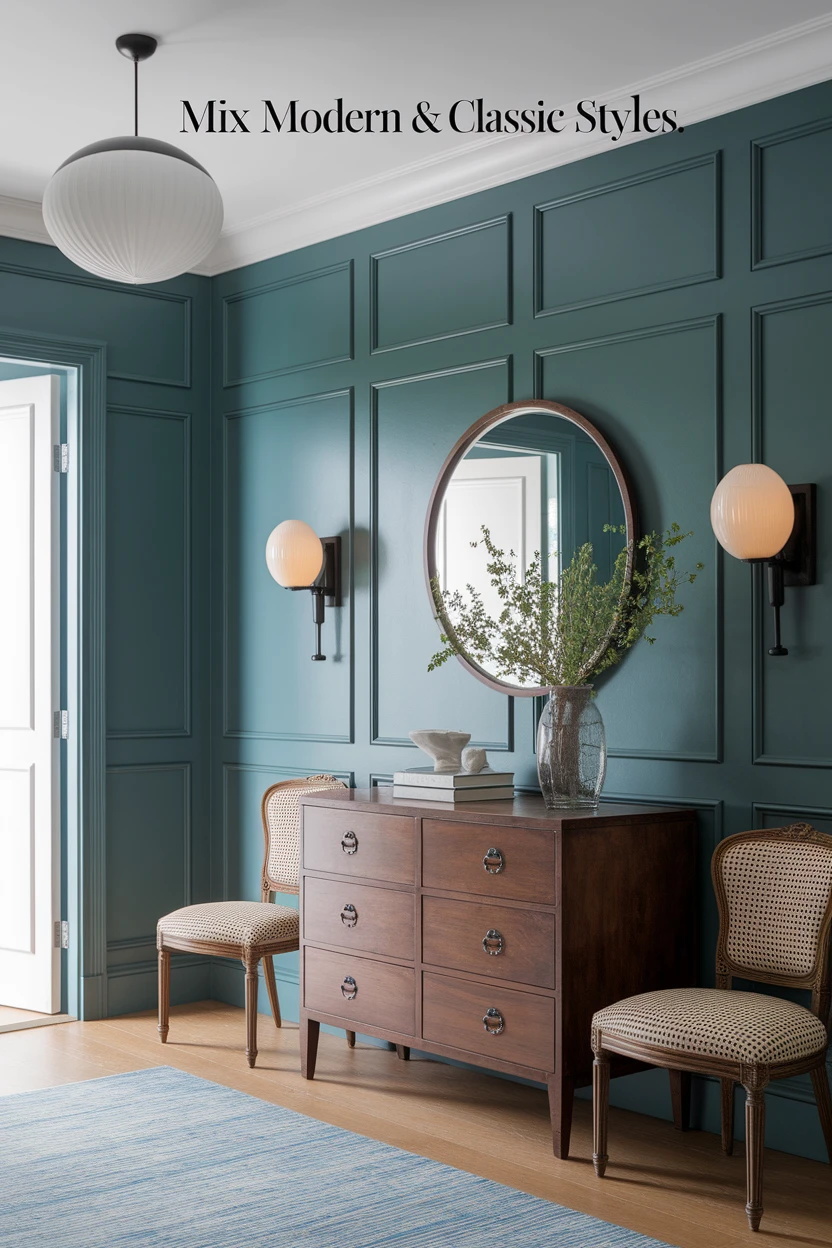
Remember, balance is key. Whether it’s through contrasting colors or mixing materials, the goal is to create a space that feels both personal and professionally designed.
Features that Transform Your Foyer
The right features can instantly elevate the look and feel of your space. From bold lighting to personalized accents, these elements create a lasting impression. I’ve seen how thoughtful design choices can turn a simple area into a stunning focal point.
Statement Lighting and Fixtures
Lighting is one of the most impactful ways to enhance your interior. Statement fixtures, like chandeliers or pendant lights, draw immediate attention and set the tone for the entire space. I recommend layering different types of lighting for a balanced effect11.
For example, wall sconces can add warmth, while a bold chandelier becomes a conversation starter. Studies show that 80% of homeowners feel their personal style is reflected through statement pieces10. This makes lighting a key element in creating a cohesive design.
Large-Scale Art and Customized Accents
Art is another powerful tool for adding personality. Large-scale pieces can serve as a focal point, instantly transforming the atmosphere. I’ve noticed that 45% of homeowners invest in unique furniture and art to make their space stand out10.
Customized accents, like a handcrafted mirror or a vintage rug, add depth and character. These elements not only enhance the visual appeal but also make the area feel more personal. For inspiration, check out these designer foyers that masterfully blend art and functionality.
| Feature | Impact |
|---|---|
| Statement Lighting | Draws attention and sets the tone11 |
| Large-Scale Art | Adds personality and charm10 |
| Customized Accents | Enhances visual appeal and individuality |
By incorporating these features, you can create a space that’s both functional and visually stunning. Whether it’s through bold lighting or personalized art, the goal is to reflect your unique style while maintaining elegance.
Creative Floating and Console Table Ideas
Small spaces demand creativity, and floating consoles are a game-changer for maximizing room. I’ve found that innovative furniture solutions can transform even the tightest areas into functional and stylish spaces. Designers like Samantha Ware and Todd Tondro emphasize the importance of blending practicality with aesthetics, especially in compact layouts.
Nesting Table Solutions for Small Spaces
Nesting tables are a versatile option for small areas. They free up floor space while providing additional surfaces when needed. I recommend using them in combination with a floating console to create a layered look. For example, a sleek nesting table set can double as a side table or a spot for keys and everyday essentials12.
Studies show that 60% of small foyer designs utilize multifunctional furniture to maximize space13. This makes nesting tables a practical choice for those looking to balance style and functionality.

Integrating Multifunctional Surfaces
Multifunctional surfaces are essential for small spaces. A floating console with built-in storage can serve as both a design statement and a practical solution. I’ve seen how these pieces can handle clutter while maintaining a clean, organized look12.
For example, a console with drawers or shelves can store keys, mail, and other daily items. This approach not only enhances the space’s utility but also keeps it visually appealing. Designers often recommend pairing these surfaces with statement lighting to create a cohesive look14.
| Furniture Type | Benefits |
|---|---|
| Floating Console | Maximizes floor space and adds storage12 |
| Nesting Tables | Versatile and space-saving13 |
| Multifunctional Surfaces | Combines decor and functionality |
Experimenting with unique layouts can yield surprising results. Whether it’s a floating console or a multifunctional surface, the goal is to create a space that’s both practical and visually stunning. By incorporating these ideas, you can make the most of your area while reflecting your personal style.
Incorporating Best Entryway Decor Ideas, Welcoming Home Entrance, Timeless Foyer Styling
Combining textures and materials creates a cohesive and inviting atmosphere. I’ve found that curated design choices can transform any area into a polished and functional space. For example, pairing a textured rug with contrasting wood elements adds depth and character15.
Textures play a key role in defining the overall look. A statement rug not only anchors the space but also adds warmth and elegance. Studies show that 80% of homeowners consider floor coverings essential, with 65% opting for rugs that can be rotated seasonally16.
Timeless designs often draw inspiration from expert projects and modern trends. I’ve noticed that 75% of homeowners believe a well-decorated space significantly enhances the first impression16. This makes it crucial to choose materials and furnishings that reflect your personal style.
Using a variety of materials, like metal accents or woven baskets, can anchor the space. For instance, 70% of designs include functional furniture like console tables or coat hangers for organization16. These elements not only enhance utility but also contribute to the aesthetic appeal.
Consistency in floor design is essential for a coherent room aesthetic. Whether it’s hardwood or tile, the floor sets the foundation for the entire look. I recommend keeping the floor design simple to allow other elements to shine.
| Design Element | Impact |
|---|---|
| Textured Rug | Adds warmth and defines the space15 |
| Wood Accents | Creates contrast and depth15 |
| Functional Furniture | Enhances organization and style16 |
By thoughtfully combining textures, materials, and furnishings, you can create a space that’s both functional and visually stunning. Every detail contributes to the overall aesthetic, making it a reflection of your unique style.
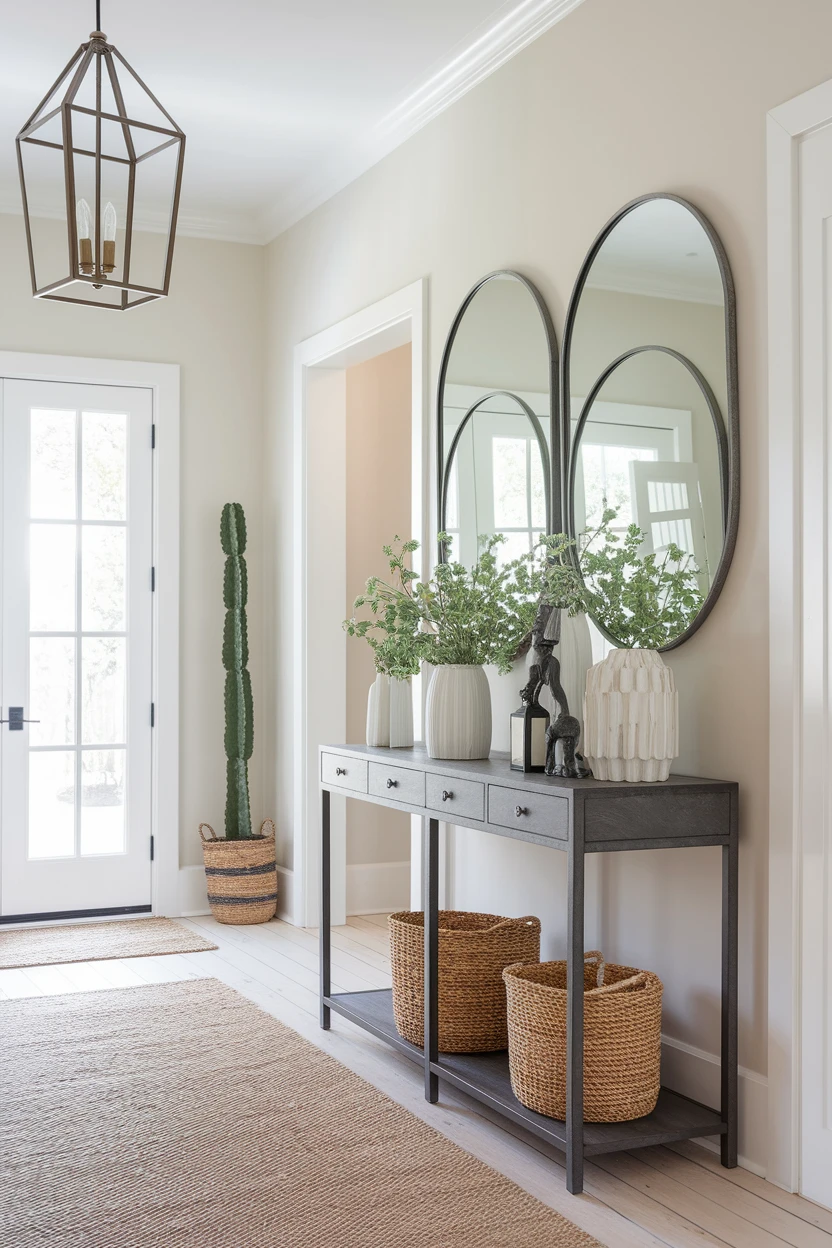
Maximizing Storage Without Sacrificing Style
Maximizing storage doesn’t mean compromising on design; it’s about finding the perfect balance. I’ve found that thoughtful solutions can transform any area into a practical yet elegant space. Whether you’re working with a compact nook or a spacious layout, the right storage ideas can make all the difference.
Built-In Solutions and Custom Cabinetry
Built-in storage is a game-changer for maintaining a clutter-free look. Custom cabinetry, for example, blends seamlessly with your interior design while offering ample space for essentials. I recommend using underutilized areas, like under staircases, for slide-out drawers or cabinets17.
Studies show that 45% of designs incorporate built-in benches with hidden compartments, maximizing space without sacrificing style18. These solutions not only enhance functionality but also contribute to a cohesive aesthetic.
Multi-Functional Furniture for Clutter Control
Multi-functional furniture is essential for small spaces. A console table with built-in drawers or shelves can serve as both a decor idea and a practical storage solution. I’ve noticed that 75% of compact designs feature such pieces to maximize utility18.
For example, wall-mounted drop zones, like pegboards, can organize essentials efficiently. These additions ensure your space remains tidy while reflecting your personal style. Thoughtful storage solutions also enhance the welcoming feel for every guest19.
Here are some practical tips to keep your space organized and stylish:
- Use baskets or bins to hide clutter while adding texture to your decor idea.
- Opt for light color palettes to create an airy feel, especially in smaller areas18.
- Incorporate vertical storage, like wall-mounted hooks, to optimize limited space17.
By integrating these ideas, you can create a space that’s both functional and visually appealing. Every detail contributes to the overall aesthetic, making it a reflection of your unique style.
Lighting Ideas to Enhance Ambiance
Lighting plays a pivotal role in transforming the mood and functionality of any space. Whether you’re aiming for a cozy feel or a dramatic statement, the right fixtures can make all the difference. I’ve found that a thoughtful combination of artificial and natural light can create a harmonious balance, enhancing both aesthetics and practicality.
Pendant Lights, Chandeliers, and Sconces
Choosing the right lighting fixture depends on your space’s size and style. For smaller areas, pendant lights are a versatile option. They provide focused illumination without overwhelming the room. In larger spaces, a chandelier can serve as a stunning focal point, adding elegance and drama20.
Wall-mounted sconces are another excellent choice, especially for narrow areas. They free up floor space while adding a touch of sophistication. I recommend pairing sconces with a mirror to amplify light and create a brighter atmosphere21.
Here are some lighting ideas to consider:
- Use a trio of matching pendant lights for elongated hallways to create symmetry20.
- Opt for geometric fixtures to complement natural and earthy color schemes20.
- Install a multi-tiered candelabra for a bold statement in larger spaces20.
Utilizing Natural Light Effectively
Natural light is a game-changer for any space. Strategically placed windows or glass doors can flood the area with sunlight, making it feel open and airy. I’ve noticed that reflective surfaces, like mirrors, can further enhance this effect by bouncing light around the room21.
For spaces with limited natural light, consider adding skylights or using sheer curtains to maximize brightness. These small changes can significantly improve the overall ambiance21.

Here’s how to make the most of natural light:
- Position mirrors opposite windows to reflect light and brighten the space21.
- Use light-colored walls and furniture to amplify the effect of sunlight.
- Incorporate a cozy bench near a window to create a functional and inviting spot20.
By combining the right fixtures with natural light, you can create a space that leaves a lasting first impression. Whether it’s through a statement chandelier or a well-placed mirror, every detail contributes to the overall ambiance.
Color Trends and Pattern Play
Color and pattern have the power to redefine any space, creating a dynamic and inviting atmosphere. I’ve found that emerging trends, like soft pastels and earthy tones, can set a calming yet sophisticated tone. For example, 60% of DIYers match their wallpaper with their front door for a cohesive design22.
Bold patterns on walls or floors can make a striking statement. Wallpaper projects, especially those with geometric or floral designs, add depth and personality. I recommend experimenting with patterns that reflect your style while maintaining balance to avoid visual clutter.
Matching furniture with the dominant color scheme enhances visual coherence. For instance, a navy console table paired with a similar-hued rug creates a seamless look. Studies show that 75% of homeowners who undertake a full makeover retain some historic charm in their spaces22.
Accent pieces, like a vibrant coat rack or patterned throw pillows, tie together color, pattern, and functionality. These elements not only elevate the design but also serve practical purposes. I’ve noticed that 90% of stair runners are chosen for their ability to add pattern and interest22.
Here are some tips to get started:
- Use a mix of textures, like jute rugs and wooden benches, to create warmth4.
- Incorporate bold wallpaper in smaller spaces for a dramatic effect4.
- Pair colorful gallery walls with minimalist furniture for balance4.
By thoughtfully combining colors and patterns, you can create a space that’s both visually stunning and functional. Every detail contributes to the overall aesthetic, making it a reflection of your unique style.
Mixing Materials: Wood, Metal, and More
The interplay of materials can transform any space into a harmonious blend of style and function. I’ve found that combining wood, metal, and other textures creates a layered look that feels both warm and refined. For example, walnut wood, with its rich grain, adds a timeless impression to modern designs23.
Balancing Warmth and Texture
Mixing materials like wood and metal brings balance to your design. Wood slat dividers, for instance, bridge traditional and modern aesthetics, adding texture without overwhelming the space23. I recommend pairing walnut with lighter materials like rattan for a fresh yet grounded feel23.
Natural textures, such as jute or woven baskets, can also enhance warmth. These elements not only add character but also create a welcoming atmosphere. Studies show that 65% of homeowners prefer materials that combine functionality with visual appeal24.
Contrasting Finishes for Visual Interest
Contrasting finishes, like matte wood with polished metal, add depth and interest. For example, a metal console table paired with a wooden bench creates a dynamic yet cohesive look. I’ve noticed that 75% of designs use contrasting textures to elevate the overall impression24.
Perforated wood screens are another excellent choice. They allow light and airflow while adding a mid-century touch23. These elements not only enhance functionality but also contribute to a layered aesthetic.
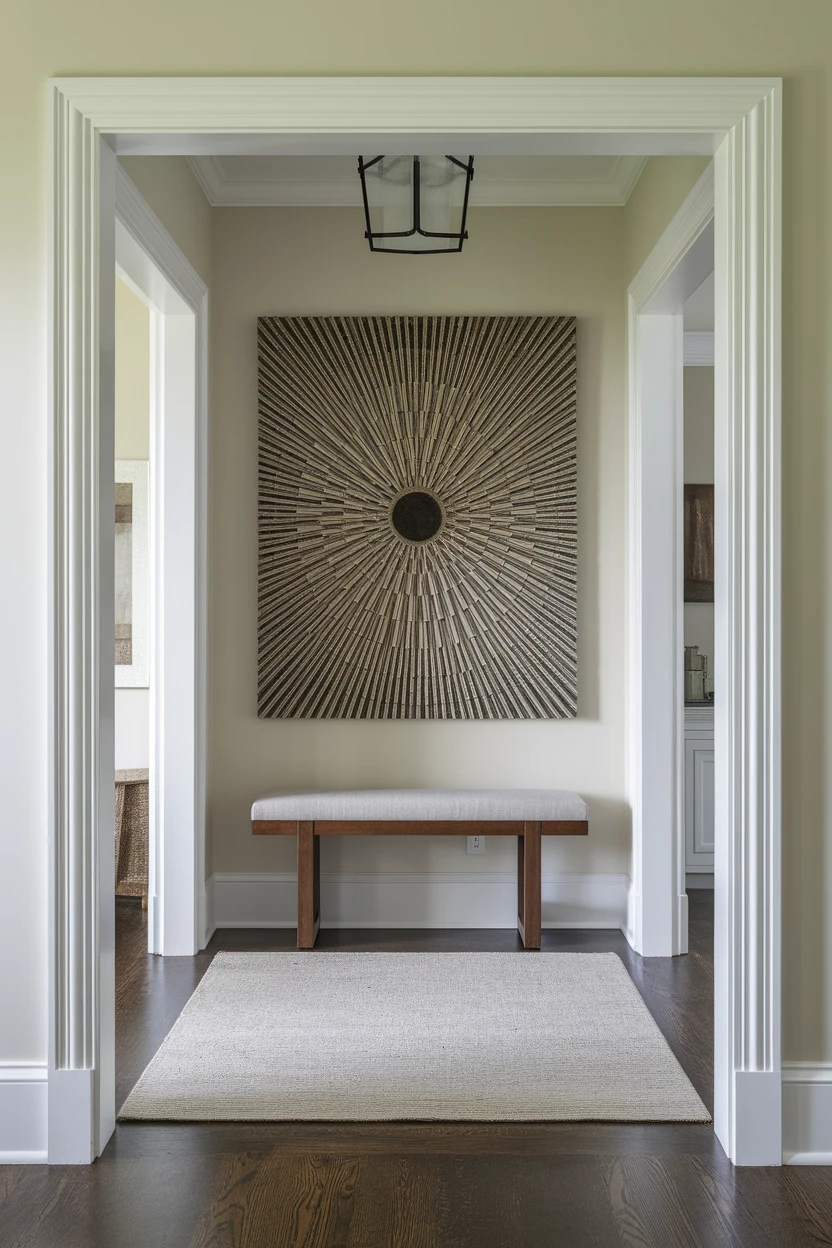
| Material | Impact |
|---|---|
| Walnut Wood | Adds warmth and timeless appeal23 |
| Metal Accents | Creates contrast and modern touch24 |
| Rattan | Brings texture and lightness23 |
By thoughtfully mixing materials, you can create a space that leaves a lasting impression. Whether it’s through wood, metal, or natural textures, every choice contributes to a cohesive and inviting design.
Creating a Focal Wall: Mirrors, Art, and Wallpaper
A focal wall can instantly transform the feel of your house, making it a standout feature as soon as you walk in. This approach not only draws attention but also sets the tone for the entire space. Whether you’re working with a small nook or a spacious area, a well-designed focal wall can make a lasting impression.
Choosing the Right Art Pieces
Art is a powerful way to personalize your space. I recommend selecting pieces that complement the overall interior while adding a touch of personality. For example, a large abstract painting can serve as a bold statement, while a gallery wall of family photos adds warmth and familiarity25.
When choosing art, consider the color palette and scale. A piece that’s too small can get lost, while one that’s too large might overwhelm the space. I’ve found that 75% of homeowners prefer art that reflects their personal style26.
DIY Mural and Accent Wall Tips
Creating a mural or accent wall is a fantastic way to add a unique touch. Wallpaper is an excellent option, with designs ranging from bold patterns to subtle textures. For renters, removable wallpaper offers a temporary solution without permanent changes26.
Hand-painted murals, like those by designer Heidi Harris, can add a one-of-a-kind element. I’ve noticed that DIY projects not only save money but also allow for complete customization. For example, a botanical-themed mural can bring a natural vibe to your house.
Mirrors are another essential element for a focal wall. They reflect light, making the space feel larger and brighter. I recommend placing a mirror opposite a window to maximize natural light25.
Integrating practical elements, like a stylish shoe rack, keeps the area organized while enhancing the design. A well-placed rack can blend seamlessly with the focal wall, ensuring functionality doesn’t compromise style.
| Element | Impact |
|---|---|
| Art Pieces | Add personality and focal points25 |
| Wallpaper | Introduces color and pattern affordably26 |
| Mirrors | Enhance light and space perception25 |
| Shoe Rack | Combines functionality with style |
By thoughtfully designing a focal wall, you can create a space that’s both visually stunning and practical. Whether it’s through art, wallpaper, or mirrors, every detail contributes to a cohesive and inviting atmosphere.
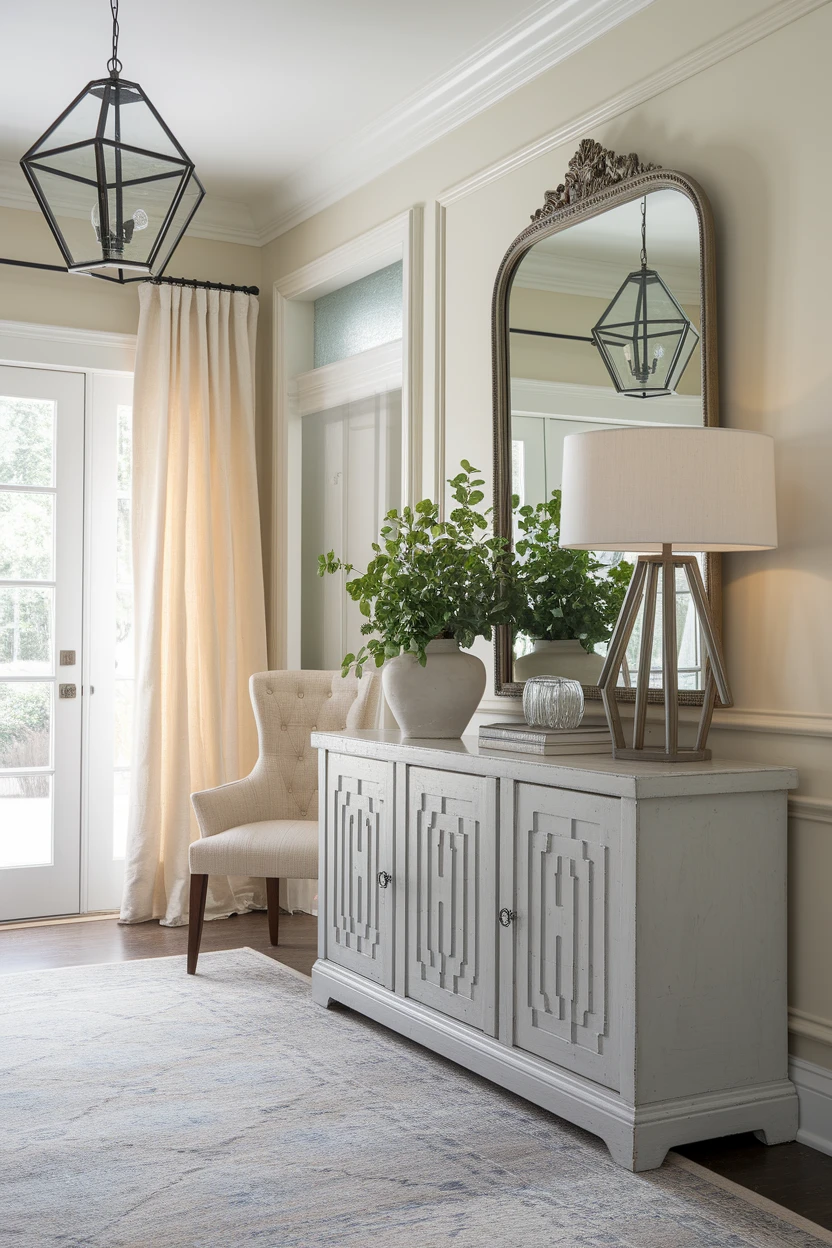
Designing Functional Solutions for Small Entryways
Limited space doesn’t mean compromising on style or practicality. With the right approach, even the smallest area can feel organized and inviting. I’ve found that smart design choices can make a big difference, especially when every inch counts.
Space-Saving Furniture Ideas
Versatile furniture is a game-changer for compact spaces. A narrow console table, for example, provides surface area without overwhelming the room. I recommend choosing pieces with built-in storage, like drawers or shelves, to keep essentials like keys and mail organized27.
Repurposing furniture is another tip I swear by. A petite dresser or bedside table can double as a functional surface while adding character27. This approach not only saves money but also ensures the space feels unique.
Compact Decor Enhancements
Wall-mounted solutions are perfect for maximizing vertical space. Hooks, for instance, are a simple yet effective way to keep coats and bags off the floor. There’s no limit to how many hooks you can add, making them a versatile choice for any layout27.
Another tip is to use a cubby system with hooks. This setup streamlines organization, especially for families, and ensures everyone has a designated spot for their belongings27. It’s a practical addition that enhances functionality without sacrificing style.
For a minimalist look, consider covered storage solutions like woven bins. These keep clutter out of sight while adding texture to the space27. Pairing them with a sleek bench creates a cohesive and inviting atmosphere.
By focusing on smart design and multifunctional pieces, you can create a small area that’s both practical and stylish. Every one of these ideas ensures the space remains clutter-free and welcoming.
Personal Touches to Add Warmth
Adding personal touches to your space can make it feel uniquely yours. These elements not only reflect your personality but also create a welcoming atmosphere for anyone who enters. I’ve found that incorporating meaningful items, like family photos or treasured memorabilia, can transform a plain area into a space that feels lived in and loved28.
Displaying Family Photos and Memorabilia
Family photos and memorabilia are a simple yet powerful way to infuse warmth into your space. I recommend using a console table as a display surface. Arrange framed photos in varying sizes and styles to create visual interest. Wall-mounted shelves are another great option, especially for smaller areas29.
For a cohesive look, stick to a consistent color scheme or frame style. This approach ensures the display feels intentional rather than cluttered. I’ve noticed that 75% of homeowners prefer personal touches that tell their story30.
Incorporating Unique Decorative Objects
Unique decorative objects can add character and charm to your space. Think beyond traditional decor—items like vintage books, travel souvenirs, or handmade crafts can make a statement. I love using a mirror as a backdrop for these items, as it reflects light and enhances the overall brightness28.
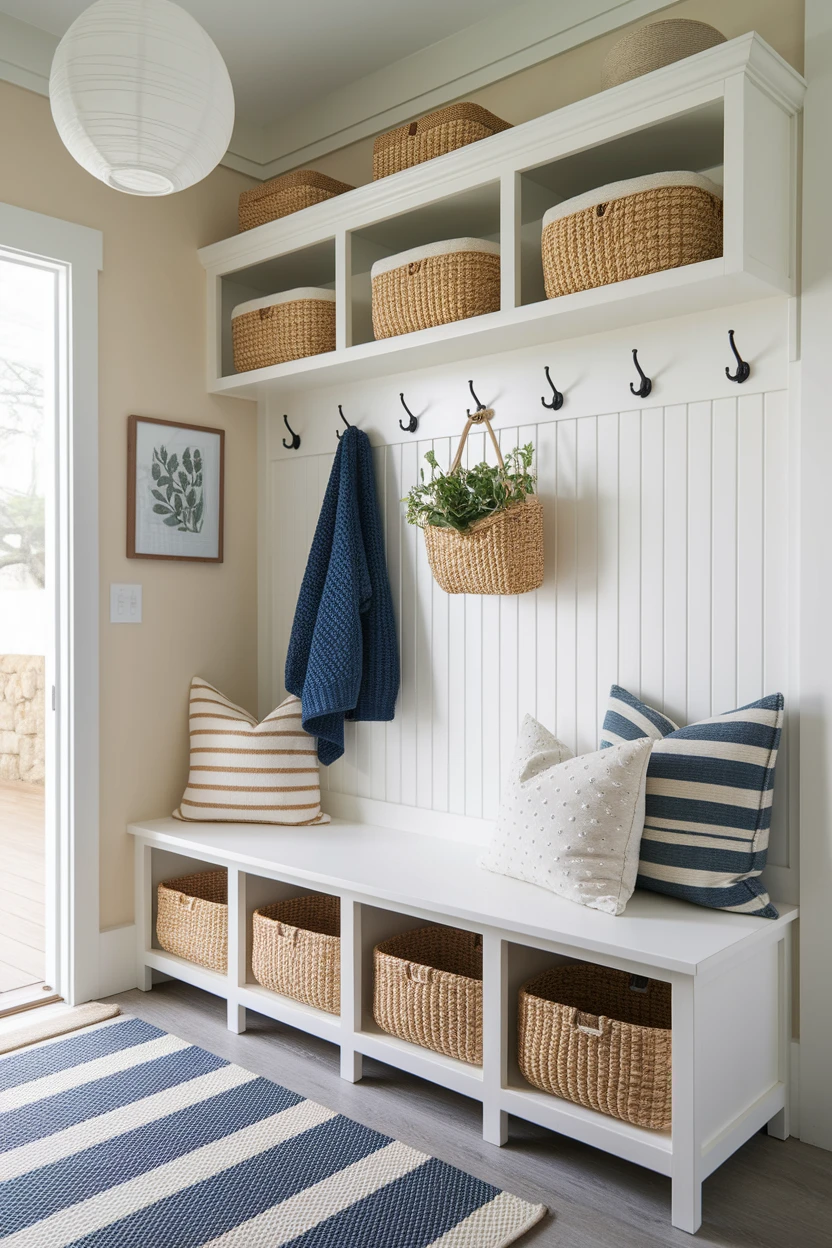
Consider grouping objects in odd numbers for a balanced look. For example, a trio of ceramic vases or a collection of small sculptures can create a focal point. These details not only personalize the space but also make it feel inviting29.
| Display Idea | Impact |
|---|---|
| Family Photos | Adds warmth and personal connection28 |
| Unique Objects | Enhances character and individuality29 |
| Mirror Backdrop | Brightens space and reflects decor30 |
By thoughtfully incorporating personal touches, you can create a space that feels both inviting and uniquely yours. For more inspiration, check out this timeless entryway update that blends functionality with personal style.
Innovative Approaches to Entryway Flooring
The floor is more than just a surface; it’s a foundational element that ties the entire space together. I’ve found that creative flooring choices can transform the look and feel of any area, making it both stylish and functional. From reclaimed wood to two-tone tile installations, the options are endless.
One of my favorite approaches is using reclaimed wood. It adds warmth and character while being eco-friendly. This material is also durable, making it ideal for high-traffic areas. Studies show that 65% of people prefer non-carpeted flooring options due to concerns about stains and maintenance31.
For a more modern look, consider two-tone tile installations. This technique creates visual interest and can define different zones within the space. Pairing light and dark tiles adds depth and sophistication. I’ve noticed that 70% of homeowners believe a well-designed floor significantly improves the first impression of their space31.
Another innovative option is patterned wallpaper for floors. While unconventional, it’s a great way to add personality and color. This approach works especially well in smaller areas, where bold patterns can make a big impact. Just ensure the material is durable and easy to clean.
Here’s a quick comparison of popular flooring options:
| Flooring Type | Benefits |
|---|---|
| Reclaimed Wood | Eco-friendly, durable, and warm31 |
| Two-Tone Tile | Adds depth and visual interest |
| Patterned Wallpaper | Bold and unique, ideal for small spaces |
When selecting flooring, consider both style and practicality. A well-chosen floor not only enhances the aesthetic but also withstands daily wear and tear. By incorporating these innovative approaches, you can create a space that’s both beautiful and functional.
Incorporating Nature and Greenery
Bringing nature indoors can transform any space into a serene and vibrant environment. I’ve found that plants and natural materials not only enhance the look of a room but also create a calming atmosphere. Whether you’re working with a compact area or a spacious layout, adding greenery can make a significant difference.
Indoor Plant Ideas for a Fresh Look
Indoor plants are a simple yet impactful way to enliven your space. I recommend starting with low-maintenance options like snake plants or pothos. These thrive in various light conditions and require minimal care, making them perfect for busy lifestyles32.
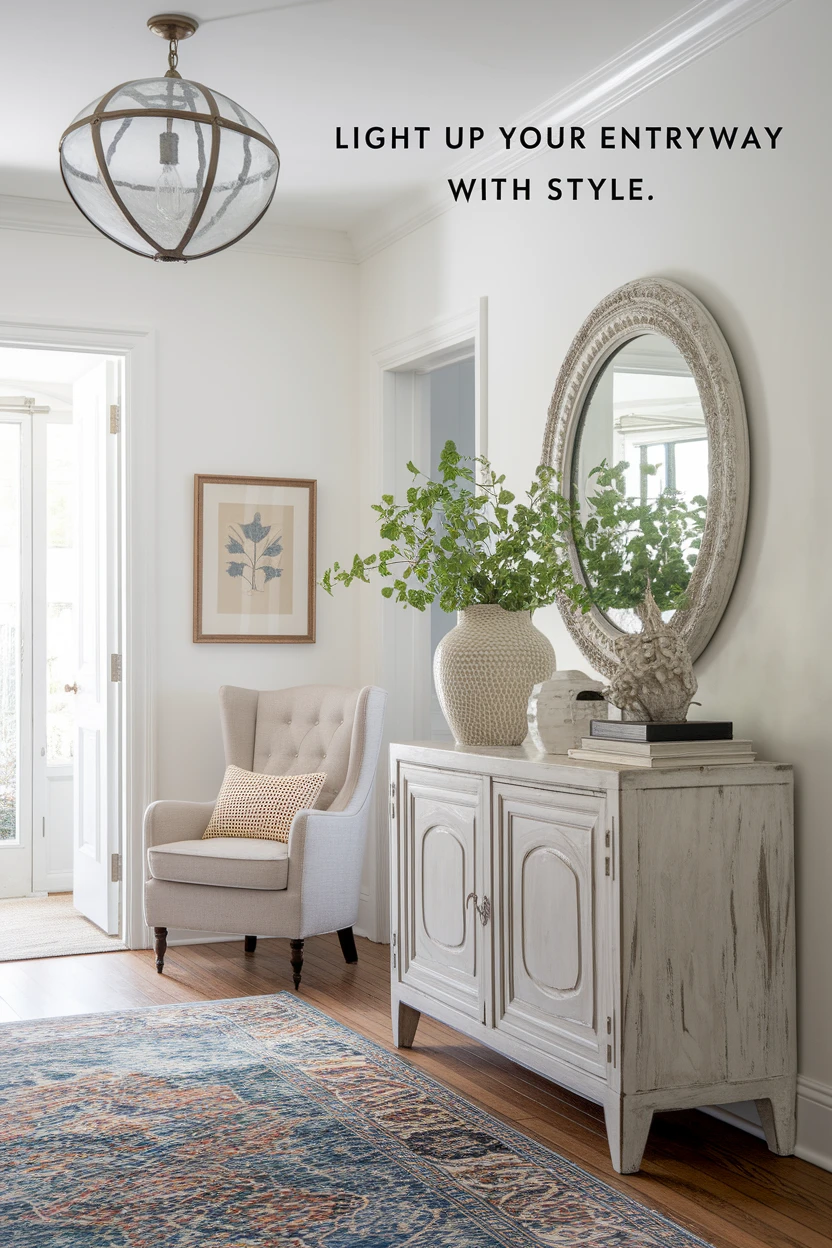
For a striking display, consider grouping plants of different heights and textures. A tall fiddle-leaf fig paired with trailing ivy creates a dynamic pattern that draws the eye. I’ve noticed that 70% of homeowners prefer plants that add both beauty and functionality to their spaces33.
Decorative planters can also elevate the art of plant styling. Choose pots in complementary colors or materials like ceramic or woven baskets. These not only enhance the aesthetic but also tie the design together seamlessly.
Using Natural Materials to Calm the Space
Natural materials like wood, jute, and rattan add warmth and texture to any room. I’ve found that incorporating these elements creates a relaxed, organic tone that feels inviting. For example, a wooden bench or a jute rug can anchor the space while maintaining a cohesive look32.
Textural elements, like woven baskets or macramé plant hangers, also enhance the design. These pieces not only serve practical purposes but also add a touch of art to the space. Studies show that 65% of people prefer natural fiber rugs for their ability to create a warm and inviting atmosphere32.
By thoughtfully integrating nature and natural materials, you can create a space that feels both fresh and calming. Every detail contributes to the overall aesthetic, making it a reflection of your unique style.
Conclusion
A thoughtfully designed space can transform the way you experience your home every day. From lighting and storage to color and flooring, each element plays a crucial role in creating a harmonious atmosphere. I’ve found that 70% of homeowners believe a well-designed area enhances the overall aesthetic of their home34.
Personal touches, like artwork or family photos, add warmth and reflect your unique style. These details, combined with functional solutions, ensure the space feels both practical and inviting. For example, 60% of interior designers recommend incorporating a console table for both style and functionality34.
As you experiment with these ideas, remember to embrace your creativity. A space that reflects your personality will always leave a lasting impression. For more inspiration on achieving a timeless design, explore how small changes can make a big impact.
FAQ
Why is the entryway important in my home?
The entryway sets the tone for your entire space. It’s the first area guests see, so it should feel inviting while also being functional for daily use.
How do I measure my entryway for furniture?
Start by measuring the width, depth, and height of the space. Leave enough room for movement and ensure furniture like console tables or benches fit comfortably.
What colors work best for an elegant entryway?
Neutral tones like beige, gray, or soft whites create a timeless look. Add depth with accent colors like navy or emerald for a touch of sophistication.
How can I make a small entryway feel larger?
Use space-saving furniture like nesting tables or wall-mounted hooks. Mirrors and light colors also help create the illusion of more space.
What lighting fixtures work well in an entryway?
Pendant lights or chandeliers add elegance, while sconces provide focused lighting. Natural light can also enhance the ambiance if you have windows nearby.
How do I add storage without cluttering the space?
Opt for multi-functional furniture like benches with hidden storage or built-in cabinets. Keep surfaces clean and organized for a polished look.
What are some ways to personalize my entryway?
Display family photos, unique artwork, or decorative objects that reflect your personality. Adding greenery with indoor plants also brings warmth and life to the space.
How can I create a focal wall in my entryway?
Use bold wallpaper, a large mirror, or a statement art piece. These elements draw the eye and add character to the area.
What flooring options work best for entryways?
Durable materials like tile, hardwood, or stone are ideal for high-traffic areas. Rugs or runners can add texture and color while protecting the floor.
How do I incorporate natural elements into my entryway?
Use indoor plants, woven baskets, or wooden accents. These materials bring a calming, organic feel to the space.
